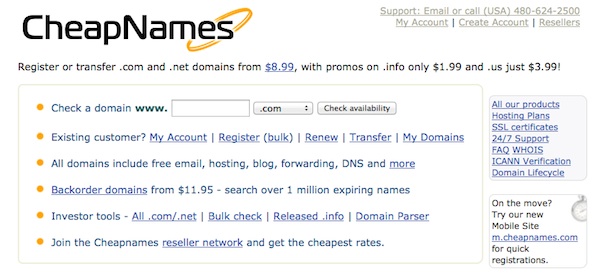Acquiring a Domain Name
Normally, obtaining a domain name is the first step in the process of deploying a website to the World Wide Web. There are, however, websites (000webhost.com is an example) that can supply one with a pseudo-domain name that really is a sub domain of one of their registered domain names. More about that later.
To acquire a domain a personal domain, one must visit one of the domain name registrar sites. There are many. Here we will look at one: cheapnames.com. First, we should understand a bit more about domain names.
What's in a (Domain) Name?
A domain name is constructed from a name, followed by a period, followed by an extension. An example is montana.edu. Things to note are:
- The first part of the domain name—montana in our example—can essentially be any name subject to certain rules given below.
- The extension must be from a standard list, including
- .com
- .org
- .biz
- .us
- .edu
- .gov
- .me
- and many others.
- The combination of the first part and the second part, which together comprise the domain name (montana.edu), must be unique in all of the world. While no one other than Montana State University can use montana.edu, some other entity can (and does) own the different domain name montana.com
- domain names can be constructed only from combinations of
- the letters a-z (capitalization does not matter)
- decimal digits (0-9)
- dashes (-).
- with the exception that a domain name cannot begin with a dash.
A Word About Extensions
The extensions were intended to imply some meaning, such as .com for commercial, for educational institution, .org for non-commercial organizations, .us for United States, and so forth. However, as the demand for domain names has grown, the list of valid extensions has also grown. For example, .biz for businesses was added because .com is in such demand that domain names that evoke some identifiable aspect of the business in question, such as ford.com, or plumbing.com have pretty much all been acquired.
Most of the extensions for domain names do not have to fall in line with their suggested meaning. For example, a person can own a domain name with a .com extension, such as rockyross.com, even though it is not intended to represent a commercial venture. However, some domain names are restricted to institutions that are represented by their extension, such as the .edu and .gov extensions.
Sub Domains
Once a unique domain name has been acquired, arbitrary sub domains can be created from that domain name. This is done by prepending a chosen name, followed by a period, followed by the domain name. So, for example, cs.montana.edu is the World Wide Web domain name of the Computer Science Department at Montana State University. Sub domains do not have to be registered or leased from a domain name registrar. Only the domain name must be registered. The domain name montana.edu will link to Montana State University, and it is up to the software at Montana State University to direct Web traffic to the sub domains inside that domain name (e.g., cs.montana.edu) properly.
Following the same principle for creating a sub domain results in sub sub domains, and so forth. So, ross.cs.montana.edu could be a valid sub sub domain of montana.edu (usually still just referred to as a sub domain). Some people have had great fun making up creative names by using name-extension combinations and/or sub domains, such as
- its-all-for.us
- its.all.about.me (which is not the same as itsallaboutme, or its-all-about.me)
- 3.14159.com (this is a subdomain formulation with 14159.com being the domain name and 3.14159.com the subdomain name; since 3.14159 is the standard value listed for pi, this would be an attractive subdomain name for certain people, and indeed is already taken).
Reserving a Domain Name
To show how easy it is to get a domain name we will use the company cheapnames.com as an example. Navigating to their site will bring up this form on their homepage.
A Snapshot of the CheapNames Website
You will notice that when you check availability you will be led to a page that lets you know whether the name you chose is available or not. If it is, you will be given the option to reserve that domain name. The price is usually pretty cheap (it is a yearly fee, not a monthly fee). Just proceed as you would with any commercial retail website: add the chosen domain name to the shopping cart and check out with a credit card.
A Final Note
Once you have a domain name, it's yours for as long as you pay the annual fee (if you have a credit card on file, the registrar comapny, such as CheapNames.com, will keep your domain names payments current). Your domain name is not attached to any computer until you set it up to be associated with your website on some computer. You can transfer it to a different computer at any time.
Moving On
The next page in this series describes how to set up an account on a server for hosting your website.